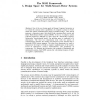Free Online Productivity Tools
i2Speak
i2Symbol
i2OCR
iTex2Img
iWeb2Print
iWeb2Shot
i2Type
iPdf2Split
iPdf2Merge
i2Bopomofo
i2Arabic
i2Style
i2Image
i2PDF
iLatex2Rtf
Sci2ools
EWHCI
1993
1993
The MSM Framework: A Design Space for Multi-Sensori-Motor Systems
One of the new design goals in Human Computer Interaction is to extend the sensory-motor capabilities of computer systems to better match the natural communication means of human beings. This article proposes a dimension space that should help reasoning about current and future Multi-Sensori-Motor systems (MSM). To do so, we adopt a system centered perspective although we draw upon the “Interacting Cognitive Subsystems” psychological model. Our problem space is comprised of 6 dimensions. The first two dimensions deal with the notion of communication channel: the number and direction of the channels that a particular MSM system supports. The other four dimensions are used to characterize the degree of built-in cognitive sophistication of the system: f abstraction, context, fusion/fission, and granularity of concurrency. We illustrate the discussion with examples of multimedia and multimodal systems, both MSM systems but with distinct degrees of builtin cognitive sophistication.
Built-in Cognitive Sophistication | Builtin Cognitive Sophistication | Cognitive Sophistication | EWHCI 1993 | Human Computer Interaction |
Related Content
| Added | 09 Aug 2010 |
| Updated | 09 Aug 2010 |
| Type | Conference |
| Year | 1993 |
| Where | EWHCI |
| Authors | Joëlle Coutaz, Laurence Nigay, Daniel Salber |
Comments (0)

